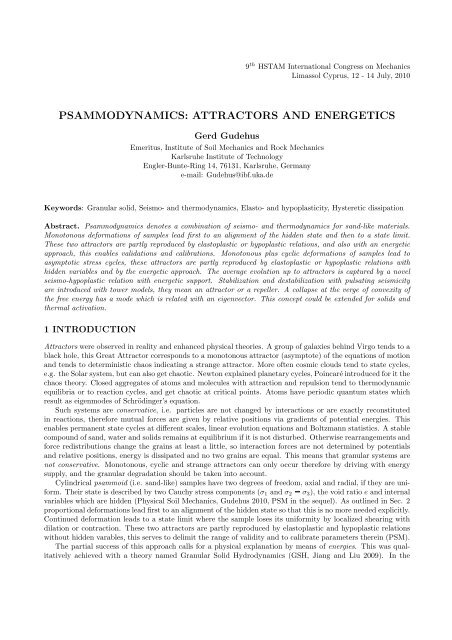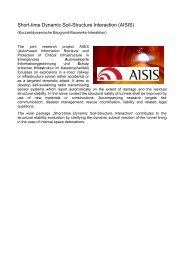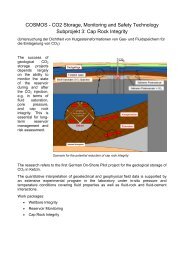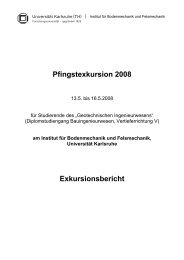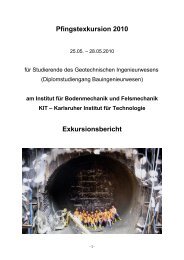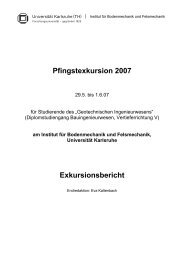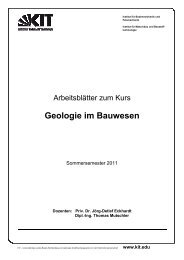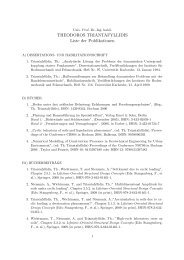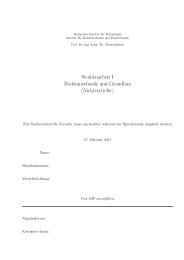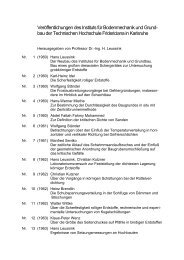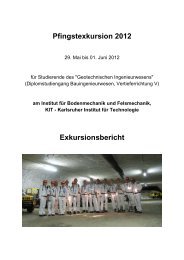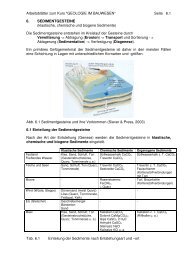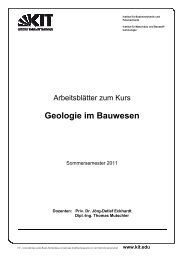PSAMMODYNAMICS: ATTRACTORS AND ENERGETICS
PSAMMODYNAMICS: ATTRACTORS AND ENERGETICS
PSAMMODYNAMICS: ATTRACTORS AND ENERGETICS
Create successful ePaper yourself
Turn your PDF publications into a flip-book with our unique Google optimized e-Paper software.
9 th HSTAM International Congress on Mechanics<br />
Limassol Cyprus, 12 - 14 July, 2010<br />
<strong>PSAMMODYNAMICS</strong>: <strong>ATTRACTORS</strong> <strong>AND</strong> <strong>ENERGETICS</strong><br />
Gerd Gudehus<br />
Emeritus, Institute of Soil Mechanics and Rock Mechanics<br />
Karlsruhe Institute of Technology<br />
Engler-Bunte-Ring 14, 76131, Karlsruhe, Germany<br />
e-mail: Gudehus@ibf.uka.de<br />
Keywords: Granular solid, Seismo- and thermodynamics, Elasto- and hypoplasticity, Hysteretic dissipation<br />
Abstract. Psammodynamics denotes a combination of seismo- and thermodynamics for sand-like materials.<br />
Monotonous deformations of samples lead first to an alignment of the hidden state and then to a state limit.<br />
These two attractors are partly reproduced by elastoplastic or hypoplastic relations, and also with an energetic<br />
approach, this enables validations and calibrations. Monotonous plus cyclic deformations of samples lead to<br />
asymptotic stress cycles, these attractors are partly reproduced by elastoplastic or hypoplastic relations with<br />
hidden variables and by the energetic approach. The average evolution up to attractors is captured by a novel<br />
seismo-hypoplastic relation with energetic support. Stabilization and destabilization with pulsating seismicity<br />
are introduced with tower models, they mean an attractor or a repeller. A collapse at the verge of convexity of<br />
the free energy has a mode which is related with an eigenvector. This concept could be extended for solids and<br />
thermal activation.<br />
1 INTRODUCTION<br />
Attractors were observed in reality and enhanced physical theories. A group of galaxies behind Virgo tends to a<br />
black hole, this Great Attractor corresponds to a monotonous attractor (asymptote) of the equations of motion<br />
and tends to deterministic chaos indicating a strange attractor. More often cosmic clouds tend to state cycles,<br />
e.g. theSolarsystem, but canalsogetchaotic. Newtonexplainedplanetarycycles, Poincaréintroducedforitthe<br />
chaos theory. Closed aggregates of atoms and molecules with attraction and repulsion tend to thermodynamic<br />
equilibria or to reaction cycles, and get chaotic at critical points. Atoms have periodic quantum states which<br />
result as eigenmodes of Schrödinger’s equation.<br />
Such systems are conservative, i.e. particles are not changed by interactions or are exactly reconstituted<br />
in reactions, therefore mutual forces are given by relative positions via gradients of potential energies. This<br />
enables permanent state cycles at different scales, linear evolution equations and Boltzmann statistics. A stable<br />
compound of sand, water and solids remains at equilibrium if it is not disturbed. Otherwise rearrangementsand<br />
force redistributions change the grains at least a little, so interaction forces are not determined by potentials<br />
and relative positions, energy is dissipated and no two grains are equal. This means that granular systems are<br />
not conservative. Monotonous, cyclic and strange attractors can only occur therefore by driving with energy<br />
supply, and the granular degradation should be taken into account.<br />
Cylindrical psammoid (i.e. sand-like) samples have two degrees of freedom, axial and radial, if they are uniform.<br />
Their state is described by two Cauchy stress components (σ 1 and σ 2σ 3 ), the void ratio e and internal<br />
variables which are hidden (Physical Soil Mechanics, Gudehus 2010, PSM in the sequel). As outlined in Sec. 2<br />
proportionaldeformations lead first to an alignment of the hidden state so that this is no more needed explicitly.<br />
Continued deformation leads to a state limit where the sample loses its uniformity by localized shearing with<br />
dilation or contraction. These two attractors are partly reproduced by elastoplastic and hypoplastic relations<br />
without hidden varables, this serves to delimit the range of validity and to calibrate parameters therein (PSM).<br />
The partial success of this approach calls for a physical explanation by means of energies. This was qualitatively<br />
achieved with a theory named Granular Solid Hydrodynamics (GSH, Jiang and Liu 2009). In the
forthcoming paper ’Seismo- and thermodynamics of granular solids’ (Gudehus et al. 2010, STG in the sequel)<br />
this theory was supported by further arguments, modified and quantified. Instead of GSH it may be called<br />
psammodynamics as psammoids are matter in its own right. This concept is shown in Sec. 2 to reproduce<br />
hypoplastic relations within bounds given by the two attractors mentioned above.<br />
Attractors for non-monotonous evolutions of cylindrical samples are introduced in Sec. 3. As long as<br />
localization and decay are avoided combinations of isochoric monotonous and cyclic deformations lead to stress<br />
cycles, these attractors serve to judge and quantify elastoplastic and hypoplastic relations with hidden variables<br />
(PSM). A unified representation enables an evolution equation relating average changes of shape and state.<br />
This rate-independent equation is supported by STG, but more experiments and simulations will be needed for<br />
a detailed validation and calibration.<br />
Systems with sand and attached solids are considered in Sec. 4. Model towers serve to introduce the total<br />
free energy which is needed to judge stability, stabilization and destabilization. Other than with an elastic<br />
ground sand gets rearranged by pulsating seismicity, with it the system can have an attractor or a repeller. The<br />
novel constitutive model is thought to predict gradual changes of position and state, whereas an impending<br />
collapse can as yet at best be estimated. Pore water and elastic structures can be incorporated, this concept<br />
works for a wide range of initial and boundary conditions. After a conclusion it is indicated in Sec. 4 how it<br />
could be applied for solids and with thermal activation.<br />
2 MONOTONOUS DEFORMATIONS OF SAMPLES<br />
Some evolutions of cylindrical sand samples (like in perfect so-called triaxial tests, PSM) are shown in Fig.<br />
1. The imposed strain paths (a, axial ε 1 , radial ε 2ε 3 ) may be proportional with contraction (A), constant<br />
volume (B) or dilation (C). The obtained stress path (b) tends to a straight line from the origin (A), a point (B)<br />
or a straight line towards the origin (C), respectively. This behavior is also visible from response polars which<br />
represent stress rates for unit strain rates with different directions. As plotted they resemble ellipses which are<br />
bigger for higher pressures and more eccentric for bigger ratios of shear and normal stress. A plot of void ratio<br />
e versus mean pressure pÔσ 1 2σ 3Õß3 exhibits an approach to limit curves (c) with p-increase (A), stationary<br />
p (B) or p-decrease (C).<br />
c<br />
C<br />
ε 1 A<br />
i<br />
√2ε 2<br />
B<br />
-c<br />
a)<br />
σ s1 c A<br />
i<br />
B<br />
C<br />
-c<br />
√2 σ s2<br />
e<br />
i<br />
c<br />
d<br />
B<br />
C<br />
A<br />
b)<br />
c)<br />
log(p s<br />
/h s<br />
)<br />
Figure 1: a) Proportional deformations of a cylindrical psammoid sample, b) induced stress paths with<br />
response polars, c) induced evolutions of void ratio versus pressure<br />
Theseevolutions,andsimilaroneswithmonotonousstrainpaths,arecharacterizedbytwokindsofattractors.<br />
Firstthehiddeninternalstateisalignedbythedeformationtothestressstatesothatitisnotneededexplicitlyin<br />
constitutive relations. Thereafter the sample approaches a state limit with a loss of uniformity, viz. compaction<br />
bands (A), shear bands (B) or decay (C). Elastoplastic relations with density hardening capture contractant<br />
and isochoric paths except for very low or high pressures, very dilatant paths with low relative void ratios are<br />
missed. Hypoplastic relations imply more realistic response polars (Kolymbas and Wu 1993) and work for a<br />
wider range of void ratios and pressures. Both models ignore the spontaneous loss of uniformity near state<br />
limits. Shear localizations can be captured by means of additional polar quantities, they arise spontaneously<br />
with bifurcation (Vardoulakis and Georgopoulos 2005 ) and can tend to fractal patterns (PSM).<br />
The grains are jammed so that they have a specific elastic energy w e which is a function of the averageelastic<br />
strain components u i and the density ρ or void ratio e. The elastic stress π i is conjugated with u i via w e by<br />
π i¡w eßu i . Due to increasing contact flats w e should depend on ∆¡Σu i by w e∆m with an exponent
m according to the grain roughness. Jiang and Liu (2009) propose m2.5, but m3 would suit better to the<br />
observed stiffnesspß∆p1ß2 . At the verge of convexity of w e the grain skeleton is no more stable, we will see<br />
below what that means. Jiang and Liu use a critical friction ratio for this verge, and an elaborate dependence<br />
on ρ so that w e∆2.5 is slightly violated.<br />
The crackling noise during deformations indicates a heat-like seismic energy w s which is not stored. In<br />
GSH this depends on a granular or seismic temperature T g by w sbρTgß2. 2 The grains get totally unjammed<br />
by minute continuous shaking so that w e vanishes and the pressure gets purely seismic and hydrostatic. Such<br />
seismodynamic equilibria with high ρ are stable due to w sT g 2 . Strong shaking causes granular boiling with<br />
expansion and convection cells, then w sT g holds as for a granular gas. Experiments indicate a boiling temperature<br />
T b10 9 K like in a Red Giant. Thus the factor b was estimated, this leads to w s10¡5 w e for<br />
deformations with rates D10¡3 /s and p1kPa (STG).<br />
The seismic energy gets lost into heat with a rate w s¡w s and a half-life t s10¡3 s for D10¡5 /s<br />
as kinks lose their energy after passing a certain number of grain contacts. w s is generated by rearrangements<br />
(intensity Dǫ1 2ǫ 2 2 ) with a granular viscosity η g. The balance of seismic energy by GSH reads<br />
2<br />
bρdTg<br />
2 g<br />
2 dt¡γT 2 η g D 2 (1)<br />
u iÔ1¡αÕε<br />
wherein γ and η g increase with T g from low values for T g0. For slow monotonous deformations T gDη gßγ<br />
is obtained as D is practically constant for much longer times than the seismic half-life t s . With a factor λ<br />
which will be explained below λη gßγ ranges from ca. 1 for T g0 to ca. 100 for T gT h100K (STG).<br />
The elastic strain u i changes by stretching and seismic relaxation within GSH via<br />
i¡λT gÔu¦i δ i ∆ß10Õ (2)<br />
with u¦i for the deviatoric part. The transmission factor α depends on T g by αα h tanhÔT gßT 2 hÕ(STG) 2 with<br />
α h0.8 (GSH). The Cauchy stress σ i is smaller than the elastic one π i by σÔ1¡αÕπ i as the contacts<br />
are seismically softened. Imagine a bicycle with a belt connecting smooth wheels instead of a chain connecting<br />
indented wheels. Stick-slip by shaking reduces the transmission and the driving moment by the same factor,<br />
similarly grain chains are imperfect and soft by seismicity.<br />
Combining these relations yields the stress rate<br />
σ iÔ1¡αÕπ i¡απ j¡Dλη<br />
i¡Ô1¡αÕH ijÔ1¡αÕε ißu j<br />
g<br />
i<br />
γÔu¦i¡δ ∆ß10Õ¡απ i<br />
(3)<br />
with the differential stiffness H ijπ . In case of a monotonous deformation with constant intensity D α<br />
tends to α h , λη gßγ to ca. 100 and T g gets stationary. Then (3) goes over into a hypoplastic relation which<br />
is thus energetically justified (GSH). The transition to the first attractor introduced above is indicated by a<br />
stationary crackling noise, which is in fact pressure-independent and louder for higher D.<br />
In the hypoplastic range, with T bT gT h100K, η gT g and γT g holds almost exactly by GSH and<br />
STG so that T g and D are simultaneously constant. This can be attributed to a rate of seismic kinksD due to<br />
evolving granular force chains with a constant transmission factor α. With higher D and thus T g seismic kinks<br />
are more often generated (bigger η g ) and propagate less far due to a stronger seismically triggered dissipation<br />
(bigger γ). The acoustic emission reflects a part of this seismic activity as some spectral fractions are enhanced<br />
by resonanceof the sample in the apparatus, while higherfractionsare damped or not audible. The seismometry<br />
is not as well developed as the thermometry.<br />
Consider e.g. a sample with p100kPa and D10¡3 /s. It has w e10J/m 3 , T g10 5 K, w s10¡6 J/m 3 ,<br />
and a seismic half-life t s10¡5 s. If a group of grains is at its verge of stability a minute seismic wave triggers a<br />
kind of snap-through. This micro-hysteresis produces heat at sliding contact flats (as observed by Luong 1982<br />
with thermography) and a kink with far less energy which is propagated and dissipated as indicated above. The<br />
dissipation power by STG is QpD as required for dry friction. With D10¡6 /s the seismic temperature<br />
T g , the rate of kinks, the inverse of the half-length of kink propagation and of the seismic half-life t s , and Q are<br />
100 times smaller than with D10¡3 /s for the same p.
With on-going deformation a stability limit is attained where the elastic energy w e is no more convex. A<br />
stronger and wilder crackling noise indicates a dramatic increase of seismicity, the approach to a state limit is<br />
thus observable. The eigenvector of w e for the verge of convexity determines a collapse modeε 2ßε 1 for which the<br />
imposed work is dissipated with maximal seismicity (STG). A similar maximality was assumed by Vardoulakis<br />
et al. (1978) for the bifurcation into localized shearing. The increasing fluctuations cause fractal patterns of<br />
shear bands (PSM) with polar quantities (Vardoulakis and Georgopoulos 2005), the emerging new degrees of<br />
freedom imply a granular chain reaction. Other than with thermodynamic sytems such critical phenomena<br />
require energy supply as the granular interactions are not conservative.<br />
3 PULSATING DEFORMATIONS OF SAMPLES<br />
A water-saturated undrained sand sample may be deformed with an amplitude ε c and an increase ε a per cycle,<br />
Fig. 2a. The zig-zag stress path tends to an asymptotic cycle which is butterfly-like for ε a0and lenticular<br />
for ε aßε cca. 1/100 (b). This driven attractor attains the critical ratio of shear and normal stress twice for<br />
ε a0 and once otherwise. With low ε c , ǫ a0 and moderate ρ the average pressure ¯p tends to zero, whereas<br />
an asymptotic ¯p0 is obtained with sufficient ε aßε c .<br />
ε<br />
σ −σ<br />
1 2<br />
c<br />
M/M 0.6<br />
c ~<br />
ε c<br />
a)<br />
t p<br />
ε a<br />
t<br />
b)<br />
M=0<br />
c<br />
p<br />
σ −σ<br />
1 2<br />
p<br />
e<br />
e - e<br />
0 d0<br />
e - e<br />
c0<br />
d0<br />
1<br />
σ −σ<br />
1 2<br />
p<br />
M c<br />
c)<br />
e 0<br />
p e d)<br />
ln(p/h ) s<br />
ε a /ε c<br />
e) ε a /ε c<br />
Figure 2: a) Deformation of a sample with pulsation and isochoric trend, b) asymptotic stress cycles without<br />
(left) and with isochoric trend (right), c) asymptotic void ratio versus pressure and equivalent pressure for an<br />
attractor, relative void ratio for p0 (d) and average stress ratio (e) versus ratio of trend and amplitude for<br />
attractors<br />
These attractors and the approach to them are well reproduced, except for small ε aßε c and low ρ, by an<br />
elastoplasticrelationwith backstress(TaiebatandDafalias2007). Theshortcomingcouldberemovedwithlimit<br />
void ratios as in Fig.1c (PSM). The attractors are obtained by a hypoplastic model with intergranular strain<br />
(Niemunis and Herle 1997) for a wider range of ǫ aßǫ c and ρ, but with flatter butterflies and faster approach<br />
than observed (PSM). Niemunis et al. (2005) proposed an accumulation model for the evolution of average<br />
shape and state with pulsations. It requires many empirical factors from triaxial tests and can lead close to the<br />
indicated attractors except for big ε aßε c , then the average stress ratioÔ¯σ 1¡¯σ 2Õßp is critical so thatÔσ 1¡σ 2Õßp<br />
is temporarily overcritical. The attractors for it can be captured by<br />
¯pp eÔa c ε m c MßM cÕ; ¯σ 1¡¯σ 2M¯p (4)
with an e-equivalent pressure p e by Fig. 2c and d, and a stress ratio M by Fig. 2e. The exponent is m2, the<br />
maximal MM c is given by a critical friction angle. M and the relative void ratio r e0Ôe 0¡e doÕßÔe co¡e increase from zero to a plateau for growing ǫ aßǫ c . M c ,e co ,e do and the granulate hardness h s are hypoplastic<br />
parameters (PSM). Parameters for the increase of r e and MßM c with ǫ aßǫ c and the factor a c are additionally<br />
needed. The case without isochoric trend may<br />
j×<br />
be called meso-hysteresis as it occurs at the scale of samples.<br />
Evolutions of the average stress with these attractors as asymptotes can be captured by<br />
σ iM ijÖε j¡Ô¡a¯pßp e bε a cε m cÕm (5)<br />
wherein the square instead of a dot denotes rates per number of cycles instead of time. Stiffness M ij and flow<br />
direction m j depend on σ i¡p d instead ofσ i by hypoplastic relations (Niemunis 2003, PSM). Therein the seismic<br />
pulsation pressure is p d¯pÔ1¡MßM cÕso that a steady state is obtained for ε aßε c0 as shown in Fig. 2b.<br />
The factors a,b and c depend on ε aßε c so that Fig. 2d and e are reproduced.<br />
Further specification and calibration require experiments and numerical simulations. Evolutions with stress<br />
cycles can be incorporated by means of control cycles with an elastoplastic or hypoplastic relation with hidden<br />
variables. This idea is taken over from Niemunis et al. (2005) and enables to use stress-controlled tests. (5)<br />
resembles the relation by Niemunis et al. (2005), but requires less parameters and implies the attractors. The<br />
extensionwith tensorsforarbitrarydeformationsislikewisestraightforward,this isneeded forframe-indifference<br />
and applicationsto boundaryvalue problems. The attractorsenable a calibrationby a singlemulti-stage triaxial<br />
test.<br />
Ô1¡αÕ2<br />
(5) is energetically justified by means of (3). Rate-independence is obtained with period times which exceed<br />
seismic half-lives by far (STG). Except for big ε aßε c , where hypoplastic behavior with nearly stationary T g is<br />
obtained, the seismicity pulsates between very low hypoelastic and moderate hypoplastic amounts. The term<br />
απ i turned out negligible in simulations with lab-typical D, this is obtained with the proposed αÔT gÕ(STG).<br />
The integration of σ i over one period, for getting average changes of shape and state in one cycle by division<br />
through its duration, can be simplified by taking averages of stiffness H ij and elastic strain u i . The stronger<br />
pulsation of λη gßγ between ca. 1 and 100, and of α between 0 and ca. 0.8, is nearly cancelled in the term<br />
ǫ i so that the average trend remains as the first term in (5). The pulsation ofÔ1¡αÕλη gßγ, however,<br />
leads to additional terms as in (5) and causes an averagereduction of u i which is represented by p d . The average<br />
differential stiffness M ij is smaller than the elastic H ij due to the average transmission byÔ1¡αÕ.<br />
This qualitative support of the proposed seismo-hypoplastc relation will not be impaired by improvements of<br />
GSH. Qualitatively realistic attractors are obtained numerically with the present version (STG). The pressure<br />
p d represents the average softening by the pulsating seismicity, it works like an excess pore pressure. The nearly<br />
complete seismic relaxation for ε a0and small ε c by (5) comes close to a seismodynamic equilibrium, the<br />
pressure ¯pεm c with m2 is due to average jamming in case of sufficient density. The stronger jamming with<br />
increasing ε aßε c is due to the built-up of elastic strain by the first term in (2). The hypoplastic limit by (5) for<br />
big ε aßε c will also be obtained with variants of GSH.<br />
4 STABILIZATION <strong>AND</strong> DESTABILIZATION<br />
doÕ<br />
A model tower stands safely upon an elastic base with a wide foundation plate, Fig. 3a. A laser pointer on<br />
top shows at the ceiling that the tower returns to an upright position (autogeneous attractor) after any small<br />
disturbance. The free energy of this conservative system, FF g F e with gravitational and elastic parts,<br />
changes with a tilt ψ from F 0 for ψ0 byÔ¡a<br />
g a eÕψ2 . Therein a g is given by mass and centre of gravity, a e<br />
by the rotational base stiffness. Stability requires a ga e so that F is minimal for ψ0.<br />
With a smaller plate the tower is no more stable (Fig. 3b) as it has a ga e . Then the upright position is<br />
an autogeneous repeller as any tilt causes a spontaneous increase of kinetic energy at the expense of F g . At a<br />
critical point with a ga e the upright position is indifferent as F does not change with small ψ. More precisely<br />
speaking, there is a fan of eigendirections with vanishing second variation of the free energy F. This holds true<br />
also for conservative systems with more degrees of freedom: equilibrium means δF0, at a critical point a<br />
collapse mode is given by an eigenvector for δ 2 F0, beyond it kinetic energy is released.<br />
The tower with the wider plate stands also safely upon dense dry sand. If it is quasi-statically loaded by a<br />
swing (Fig. 3c) it remains in an upright position, but sinks graduallyby minute amounts. If it was slightly tilted<br />
after placement on dense sand it returns gradually by swinging (one can see that with the laser pointer) and
a) b)<br />
c) d)<br />
Figure 3: Model tower upon elastic base with sufficient (a) and insufficient foundation (b), and upon dense<br />
sand with stabilization (c) and destabilization (d) by a swing<br />
goes on to sink slightly. A microphone reveals a pulsating crackling noise, so one may speak of a seismogeneous<br />
attractorwith macro-hysteresis. This stabilization occurs alsoby repeated shocksat the baselike an earthquake.<br />
The tower with the smaller plate on dense sand (Fig. 3d) behaves differently. It tilts and sinks gradually<br />
from an upright position by swinging, so we have a seismogeneous repeller. When the tower has reached a<br />
critical tilt it topples spontaneously with more and more crackling noise. This seismogeneous destabilization<br />
occurs likewise with repeated base shocks. The collapse requires an amplitude-independent critical tilt and has<br />
a mode which is determined by mass and dimensions of the tower plus foundation and by the density of the<br />
sand nearby.<br />
A stabilization occurred repeatedly with a TV tower in Moscow and with gravity offshore structures: after<br />
tilting in a gale the structures turned upright again and sunk gradually with normal wind or waves. The<br />
seismogeneous stabilization with re-densification can occur without back-tilt, e.g. with piles, and the gradual<br />
displacements can impair the serviceability, e.g. of machines or tracks. A destabilization can happen more<br />
dramatically with water: structures can suddenly slump in loose saturated sand, originally dense sand can be<br />
gradually dilated and offshore structures can topple after having reached a critical point.<br />
The importance is evident, but published mechanical models are rather insufficient. So can the proposed
psammodynamic concept do better, at least for our model towers on dry sand? The free energy is again<br />
FF g F e as its seismic part is negligible (cf. Sec. 2), but its degrees of freedom are not as simple and unique<br />
as for conservative systems with elastic ground. The pulsating seismicity triggers rearrangements and stress<br />
redistributions, F drops gradually with decreasing rate for stabilization and increasing rate for destabilization.<br />
At a critical point F drops spontaneously with increasing seismicity and kinetic energy of the average motion,<br />
until the toppling tower reaches the ground.<br />
The swing produces quasi-static evolutions in the sand, like wind or waves in situ. The specific seismic<br />
energy w e , though far smaller than the elastic one w e except near free surfaces, can be bigger than the kinetic<br />
energyof averagedisplacements as long as the system is stable. Then the evolution is rate-independent asshown<br />
in Sec. 3, a tensorial extension of (5) could be employed. The field of cyclic deformation amplitudes could be<br />
calculated with a validated and calibrated elastoplastic or hypoplastic model with hidden variables for a few<br />
control cycles, as proposed by Niemunis et al. (2005) an updating is needed after substantial changes of average<br />
position and state field. This works also with constraints by pore water and embedded elastic structures, then<br />
the relaxation of the grain skeleton by pulsating seismicity can play a bigger role.<br />
This approach works also with destabilizations, but was not yet properly worked out for critical points.<br />
For a tower upon dry sand an impending collapse may be indicated by the impossibility to get quasi-static<br />
hypoplastic solutions. A proper mode of collapse should result from an eigenvalue of the total free energy as a<br />
functional of configurationand state field. It is not yet known how this could workwith finite elements, i.e. with<br />
an eigenvector in a Sobolev space. It appears that spontaneous granular chain reactions get increasingly fractal<br />
by localizations, so extended continuum approaches are required (with fractional calculus?). Localizations are<br />
more complex with pore water and gas if the grain skeleton opens into channels or films (PSM).<br />
5 CONCLUSIONS <strong>AND</strong> OUTLOOK<br />
Thedynamicsofsand-likematter(psammoids), calledpsammodynamics,canbecapturedbymeansofattractors<br />
and energetics. Monotonous deformations cause an alignment of the internal state so that this is not needed<br />
explicitly. The response is better captured by hypoplastic than by elastoplastic relations, this is justified with<br />
a granular temperature which is proportional to the intensity of stretching D. The seismic energy is stationary<br />
for constant D as its loss into heat is compensated by its generation by D. At state limits the elastic energy is at<br />
the verge of convexity, thus the seismic energy grows dramatically by imposed work and triggers localizations.<br />
Samples with average plus cyclic deformations tend to stress cycles or skeleton decay. These attractors are<br />
partly reproduced by elastoplastic or hypoplastic relations with back stress or intergranular strain, respectively,<br />
as hidden variables. Attractors are proposed for evolutions of average shape and state, and also obtained with<br />
a novel seismo-hypoplastic relation. This is justified with a pulsating seismicity in the subcritical range which<br />
causes an average softening of the grain skeleton. As for monotonous deformations the rate-independence is<br />
justified as D is nearly constant over times which exceed by far the time for the transition of seismic energy into<br />
heat. The crackling noise and the range of hysteresis from micro (grain) to meso (sample) indicate fractality.<br />
Boundary conditions with pulsating seismicity (macro-hysteresis) can lead to stabilization or destabilization<br />
of towers upon sand. Depending on the foundation width the upright position can work as attractor or repeller.<br />
In the second case the tower tends to a critical tilt where it topples by itself. This concept can be transferred<br />
to other cases including pore water and elastic solids, but the loss of stability is not yet well understood. The<br />
mode of a collapse is principally determined by an eigenvector of the free enegy at the verge of convexity.<br />
The subsequent granular chain reaction as a succession of eigenvalue problems is more complex by increasing<br />
fractality.<br />
The seismodynamic approach will be improved with refined energies, particularly for the verge of convexity.<br />
For a while elastoplastic, hypoplastic and seismo-hypoplastic models will serve to the purpose as far as they are<br />
validated and calibrated. The approach could also be applied to solids. Their acoustic emission in the ductile<br />
(stable) regime indicates seismicity from micopores. Its intensity or seismocrasy (analog of Greek thermocrasia<br />
= temperature) T s enhances relaxation and dissipation so that stresses evolve with strain similarly as by (3).<br />
This could support and improve elasto- and hypoplastic relations (PSM).<br />
The indirectly audible seismic kinks may be called seismons as they resemble phonons in solids and remind<br />
of radiactivity observed with a Geiger counter. The similarity to quantum mechanics may be more than<br />
accidential, but we are far from a seismic counterpart of Schrödinger’s equation. The thermal activation by<br />
phonons comes into play with very slow evolutions and/or softer solid particles. Quartz sand under tectonic
deformation with D10¡13 /s, e.g., has viscous creep-relaxation as phonons matter more than seismons. Clays<br />
wih lower activation energies feel seismons and phonons likewise for geotechnicallly usual D. An extension of<br />
(2) for thermal relaxation could support and improve viscoplastc relations (PSM).<br />
ACKNOWLEDGEMENT: This paper ripened in many discussions with Karl Balthasar, Gerhard Huber, Andrzej<br />
Niemunis, Mauro Poblete, Oksana Solf, Asterios Touplikiotis, Torsten Wichtmann and Holger Wienbroer.<br />
Technical advice from these scientists is greatfully acknowledged.<br />
REFERENCES<br />
Gudehus G.: Physical Soil Mechanics. Springer, Berlin etc., under print 2010<br />
Gudehus G, Jiang Y. and Liu M.: Seismodynamics and thermodynamics of granular solids. Submitted to<br />
Granular Matter 2010<br />
Jiang Y. and Liu M.: Granular Solid Hydrodynamics. Granular Matter 11: 139-156, 2009<br />
Kolymbas, D. and Wu W.: Introduction to Hypoplasticity. In Modern Approaches to Plasticity, Ed. D.<br />
Kolymbas, 213-224, Elsevier, Amsterdam etc. 1993<br />
Luong M. P. : Mechanical aspects and thermal effects of cohesionless soils under cyclic and transient loading.<br />
In Proc. IUTAM Conf. Deform. Failure of Gran. Mater., Delft, 239-246, 1982<br />
Niemunis A.: Extended Hypoplastic Models for Soils, monography, Polytechnica Gdanska 2003<br />
Niemunis A. and HerleI.: Hypoplasticmodel for cohesionlesssoilswith elastic strainrange. Mech. Cohes.-Frict.<br />
Mat. 2, 279-299, 1997<br />
Niemunis A., Wichtmann T. and Triantafyllidis T.: A high-cycle accumulation model for sand. Computers and<br />
Geotechnics, Vol. 32/4, pp. 245-263, 2005<br />
Taebat M. and Dafalias Y. F.: SANIS<strong>AND</strong>: Simple anisotropic sand plasticity model. Int. Journ. Numer.<br />
Anal. Meth. Geomech., 2008<br />
Vardoulakis I., Goldscheider M. and Gudehus G.: Formation of shear bands in sand bodies as a bifurcation<br />
problem. Int. Journ. Numer. Anal. Meth. Geomech., 2:99-128, 1978<br />
Vardoulakis I. and Georgopoulos J. O. : The ’stress-dilatancy’ hypothesis revisited: shear-banding related instabilities.<br />
Soils and Foundations, 45(2): 61-76, 4 2005


